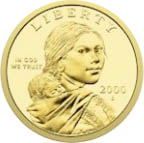Jean Baptiste Charbonneau
|
|
Jean Baptiste Charbonneau (February 11, 1805 – May 16, 1866) the son of the French Canadian interpreter Toussaint Charbonneau and Sacagawea, the Shoshone guide of the Lewis and Clark Expedition. He was born during the expediton's journey westward at Fort Mandan.
His image can be found on the United States dollar coin along with his mother, Sacagawea.
Expedition co-leader William Clark nicknamed him "Pomp" or "Pompy." Pompey's Pillar on the Yellowstone River in Montana is named after him.
Years after the expedition, the Charbonneau family moved to St. Louis at Clark's invitation. Clark paid for young Jean-Baptiste Charbonneau to attend school there, and continued to oversee his care and schooling when Sacagawea returned up the Missouri River with the elder Charbonneau.
At the age of 18, Charbonneau met Prince Paul Wilhelm of Württemberg (nephew of King Fredrick I). The prince, traveling in America on a natural history expedition, invited Charbonneau to return to Europe with him, where he lived for six years and learned to speak four European languages. He travelled all over Europe and even visited Africa.
In 1829 Charbonneau returned to North America, where he lived as a mountain man and army scout. He guided the Mormon Battalion from New Mexico to the city of San Diego in California in 1846, and then accepted an appointment there as alcalde of Mission San Luis Rey. He was eventually forced to resign from that post after his repeated attempts to improve the condition of the local Native American tribes caused political trouble for him.
Charbonneau then got caught up in the California gold rush sweeping the state, and joined thousands of other "49ers" in Placer County. Still chasing the elusive dream of riches, he died (apparently of bronchitis) in Danner, Oregon at the age of 61, while enroute from California to the new gold fields discovered around Virginia City in Montana.
There is a burial site for Charbonneau in Oregon, generally believed to be the correct one. There is another grave site and memorial in Fort Washakie, Wyoming, but it is disputed whether the body interred there could be his.

